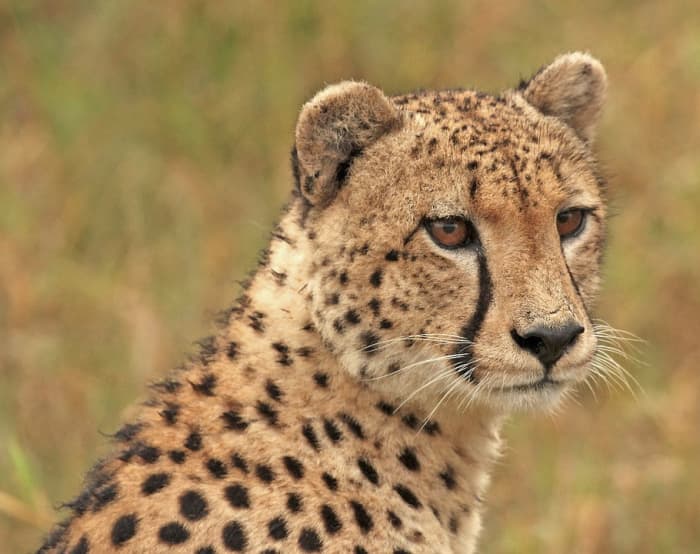Top 50 Amazing Sahara Desert Animals

Caracals, dromedary camels, jerboas, and cheetahs are just four animals that have adapted to survive in the Saharah.
slowmotiongli, Yerbolat Shadrakhov, Freder from Getty Images; KellyvanDellen via Canva Pro
Introduction
Occupying almost all of North Africa, the Sahara is the world's largest desert. The desert is full of large oasis depressions, shallow inundated basins, sand seas, dunes and sheets; abrupt mountains, rocky plateaus, and gravel plains. Its temperature is extremely hot during the day and extremely cold during the night.
Despite the region's extreme conditions, however, hundreds of animal species still thrive there. These Sahara Desert animals have adapted well to their environment, and their bodies are well-equipped to survive the cruelty of nature.
Animals That Continuously Survive Living in the Sahara Desert
1. Addax Antelopes | 26. Cobras |
2. Dromedary Camels | 27. Chameleons |
3. Saharan Cheetahs | 28. Skinks |
4. Dorcas Gazelles | 29. Dwarf Crocodiles |
5. Deathstalker Scorpions | 30. Lions |
6. Fennec Foxes | 31. Gerbils |
7. Dung Beetles | 32. Cape Hares |
8. North African Ostriches | 33. Fallow Deer |
9. African Wild Dogs | 34. African Wild Asses |
10. Horned Vipers | 35. Striped Polecats |
11. Hyraxes | 36. Bateleur Eagles |
12. African Silverbills | 37. Guinea Fowls |
13. Desert Monitor Lizards | 38. African Spotted Eagle Owls |
14. Desert Crocodiles | 39. Sand Cats |
15. Saharan Silver Ants | 40. Pale Crag Martins |
16. Golden Jackals | 41. Fan-Tailed Ravens |
17. Jerboas | 42. African Clawed Frogs |
18. Olive Baboons | 43. Caracals |
19. Nubian Bustards | 44. Denham’s Bustards |
20. Desert Hedgehogs | 45. Lappet-Faced Vultures |
21. Slender Mongoose | 46. Mouse-Tailed Bats |
22. Spotted Hyenas | 47. Cairo Spiny Mouse |
23. Barbary Sheep | 48. Desert Long-Eared Bats |
24. Oryx | 49. Kobs |
25. Secretary Birds | 50. African Mantis |
1. Addax Antelopes
These Saharan animals have ringed, twisted, long horns. They have the capability to change their coat colors. During winter, they have grayish-brown coats. During summer, they have sandy-beige to white coats.
These antelopes live in the stony, sandy, and dry steppe areas of the Sahara Desert. They are herbivores. They prefer to eat the Panicum grass, especially the shoots and seeds. However, they will also eat other kinds of grasses, herbs, and shrubs.
The male addax antelope is bigger than the female. The average body length is between 150 centimeters and 170 centimeters. The average body weight is between 60 kilograms and 125 kilograms for females and between 99 kilograms and 124 kilograms for males.
The average life span of addax antelopes in the wild is 19 years. They start to become sexually mature when they are two years old. Their mating season is at its peak during the start of spring. The gestation period is about nine months. Females give birth to only one baby with each pregnancy. The babies are dependent on their mother's milk from birth up to 29 weeks.
The addax antelope species is now critically endangered. Their population in the wild is only a handful. In Niger, there are less than 10 of them found in the Termit Massif Reserve. There are also a number of sightings of addax antelope in other parts of Africa.
Some organizations in the United States and some Middle Eastern countries have captive-bred these animals to help preserve their kind. A number of them have been reintroduced into the wild in Morocco and Tunisia.
2. Dromedary Camels
The arid climate in the Sahara Desert is the perfect habitat for dromedary camels. This is the reason why most of these camels are domesticated by the people living in or near the Sahara Desert. These people use camels for the transport of people and cargo in the area.
Dromedary camels are herbivores. They eat all kinds of plants that are thriving in the Sahara. This is their advantage against other herbivores in the desert. These camels will eat even those thorny plants that other animals don't like to eat. Their thick lips help them to eat any thorny plant without getting hurt.
Dromedary camels are tall animals. They are about 6.5 feet tall up to their shoulders. When the height of their hump is added, their height will reach up to about 10 feet in total. They are also heavy. Their average weight is between 1000 pounds and 1500 pounds.
One thing to remember about dromedary camels is that they only have one hump. If you see a camel with two humps, then it is the other breed of camel called the Bactrian Camel. The number of humps is the distinguishing factor between these two camel breeds.
Recommended
The hump of the camel is an important body part. This is where camels store their fatty tissue. On days when no food or water is available, the camels' bodies will use the stored fatty tissue to survive. They can last for many days without food and water in the Sahara Desert because of their humps.
The length of gestation of female dromedary camels is about 13 months. Most of the time, they will give birth to only one baby. However, there are also instances wherein two or more baby camels are born from a single pregnancy.




